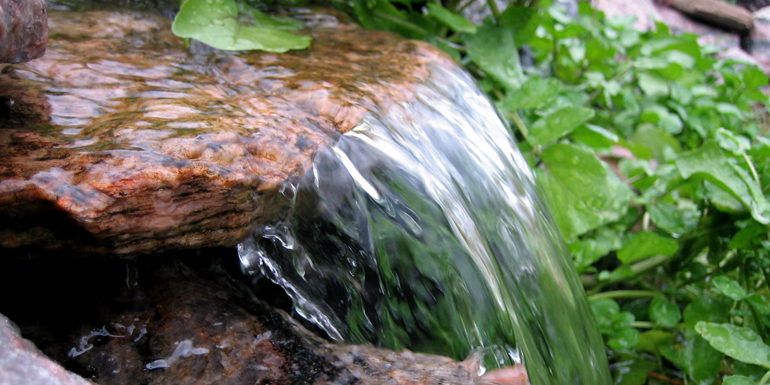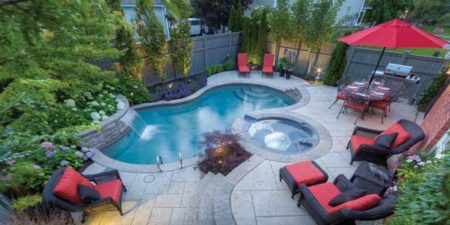Waterfalls and streams
Waterfalls create a focal point and produce soothing sounds as water cascades over stones and boulders before returning to the pond. The moving water also improves water quality by oxygenating the pond, creating a more balanced ecosystem. If your property is naturally sloped, consider incorporating a stream into the hill; vary the width and depth for a more natural look. If you have a flat property, the excess soil excavated for the pond can be used to form berms or banks, which can create a starting point for the waterfall.
Lighting
The use of lighting in and around your pond can bring it to life in the evening and extend its hours of enjoyment. There are different ways to use lighting depending on what type of look you are trying to achieve.
Placing a submersible light under or behind a waterfall gives off shimmering waves of light, producing a stunning effect. You can also place lights deeper in the pond shining up towards the surface. This produces a beautiful luminous glow and if you have fish, allows you to see their silhouettes as they slowly swim by. Although halogen lights have traditionally been the industry standard, more manufacturers have introduced light-emitting diode (LED) fixtures in recent years. LED lights are long lasting, come in a variety of colours, are exceptionally energy efficient and can be used in or out of the pond.
Choosing the proper pond equipment
Pumps
Choosing the right pump can be a bit confusing, as there are many models and brands to choose from. Although the initial purchase price is usually the main consideration, there are a few other more important characteristics to bear in mind, including flow rate, design and operating costs. The required size or flow rate of the pump should be based on the pond volume. Ideally, a pump should circulate the entire volume of water a minimum of once every hour. For example, if you have a 3,785-L (1,000-gal) pond, you should have a 3,785-litre per hour (lph) (1,000-gallon per hour [gph]) pump or larger. Many pond owners choose to operate larger pumps than what is required to achieve a more substantial flow over their waterfall.
Often overlooked, yet very important, is the pump’s overall operating cost. Since pumps should be operated 24 hours a day during the spring, summer and fall, choosing an energy-efficient model can translate into substantial savings. This type of pump may be more expensive at first, but when energy savings are factored in, it can soon pay for itself.












